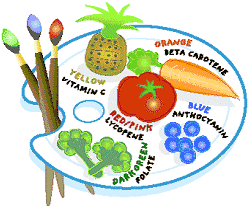



|
 |

Color Your Way to 5 A Day
More Color More Health
 Growing up you may have been told to eat your greens, but what about your reds, oranges, yellows and blues? The Centers for Disease Control and Prevention and the 5 A Day Partnership encourages YOU to "Sample the Spectrum" of the colorful vegetables and fruit available this season. By putting something of every color on your plate or in your lunch bag, you are more likely to eat the 5 to 9 recommended servings of vegetables and fruit every day. Just think: 1 cup of dark, leafy GREENS, ½ cup of RED tomatoes, ½ cup of YELLOW peppers, 6 oz. ORANGE juice and ½ cup of BLUEberries. And you have 5 A Day! It’s quite simple when you Sample the Spectrum. Growing up you may have been told to eat your greens, but what about your reds, oranges, yellows and blues? The Centers for Disease Control and Prevention and the 5 A Day Partnership encourages YOU to "Sample the Spectrum" of the colorful vegetables and fruit available this season. By putting something of every color on your plate or in your lunch bag, you are more likely to eat the 5 to 9 recommended servings of vegetables and fruit every day. Just think: 1 cup of dark, leafy GREENS, ½ cup of RED tomatoes, ½ cup of YELLOW peppers, 6 oz. ORANGE juice and ½ cup of BLUEberries. And you have 5 A Day! It’s quite simple when you Sample the Spectrum.
The more reds, oranges, greens, yellows, and blues you see on the plate, the more health promoting properties you are also getting from your vegetable and fruit choices. Nutrition research shows that colorful vegetables and fruit contain essential vitamins, minerals, fiber, and phytochemicals that your body needs to promote health and help you feel great. Here are the specifics…
Reds
When you add deep reds or bright pinks to your daily diet, you are also adding a powerful antioxidant called lycopene. Lycopene is found in tomatoes, red and pink grapefruit, watermelon, papaya and guava. Diets rich in lycopene are being studied for their ability to fight heart disease and some cancers.
Greens
Do you know why this color is so essential to your diet? Not only do green vegetables look great and taste wonderful, but they are rich in the phytochemicals that keep you healthy. For example, the carotenoids lutein and zeaxanthin that are found in spinach, collards, kale and broccoli have antioxidant properties and are being studied for their ability to protect your eyes by keeping your retina strong. Also, research is being done on cruciferous vegetables like cabbage, Brussels sprouts, cauliflower, kale, and turnips to see if they may reduce the risk of cancerous tumors! Greens are also loaded with essential vitamins (folate), minerals, and fiber.
Oranges/Yellows
Orange, the color of a blazing sun, is a must have in your daily diet. Orange vegetables and fruits like sweet potatoes, mangos, carrots, and apricots, contain beta-carotene. This carotenoid is a natural antioxidant that is being studied for its role in enhancing the immune system. In addition to being touted as a powerful health-protector, the orange group is rich in Vitamin C. Folate, most often found in leafy greens, is also found in orange fruits and vegetables, and is a B vitamin that may help prevent some birth defects and reduce your risk of heart disease. With a chemical make-up this good, make the orange group always a part of your 5 to 9 a day.
Bright yellows have many of the same perks as the orange groups: high in essential vitamins and carotenoids. Pineapple, for example, is rich with Vitamin C, manganese, and the natural enzyme, bromelain. Additionally, corn and pears are high in fiber. Yellow fruits and vegetables belong to many different families, but they all share the common bond of being health enhancing with great taste. Go for the gold!
Blues/Purples
Blues and purples not only add beautiful shades of tranquility and richness to your plate, they add health-enhancing flavonoids, phytochemicals, and antioxidants. Anthocyanins, a phytochemical, are pigments responsible for the blue color in vegetables and fruits, and are being studied for their role in the body’s defense of harmful carcinogens. Blueberries, in particular, are rich in Vitamin C and folic acid and high in fiber and potassium.
Whites
Vegetables from the onion family, which include garlic, chives, scallions, leeks, and any variety of onion, contain the phytochemical allicin. Research is being conducted
on
-
Allicin to learn how it may help lower cholesterol and blood pressure and increase the body’s ability to fight infections.
- Indoles and sulfaforaphanes, phytochemicals in cruciferous vegetables like cauliflower, for how they may inhibit cancer growth.
- Polyphenols, another important phytochemical in pears and green grapes for how they may reduce the risk of certain cancers.
Savor the Spectrum All Year Long
There is color in every season. When it comes to your health, you’ll fare best with a multi-colored diet. By putting something of every color on your plate or in your lunch bag, you are more likely to eat the recommended 5 to 9 servings of vegetables and fruits every day. Think color: 1 cup of dark, leafy salad GREENS with WHITE onions sprinkled on top, ½ cup of RED tomatoes, ½ cup of YELLOW pineapple chunks, 6 oz. ORANGE juice and ½ cup of BLUEberries. Delicious and healthy!
Get your "5 to 9 A Day" the Colorful Healthy Way!
|
|
